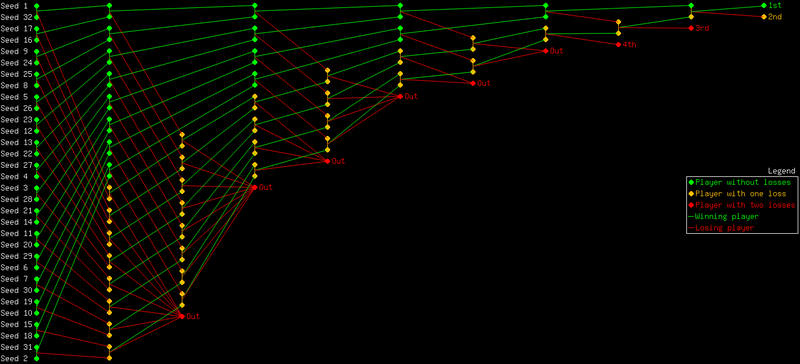Double Knockout Tournament Format
The Double Knockout Tournament Format, also known as Double Elimination, is a format for pairing players to play games in tournaments. Unlike a single knockout, where players are eliminated immediately upon losing any game, in a double knockout players are eliminated only after losing two games.
Purpose of the system
The double elimination format is especially suitable for important championships, or other tournaments where a single winner must be found, but the results need to be more credible than those of a single knock-out tournament.
The basic idea of the system is: Any player who lost two games did not deserve to become the champion.
The Pairing Method
In the first round, all players are paired to play, possibly according to some seeding. If the number of players is not a power of two, some kind seeding is needed to award the free rounds. Those players that lose are moved to the losers bracket. Those players that win are moved to the winners bracket.
Subsequently, players in the losers bracket play every round, with the losers eliminated from the tournament, while the winners remain in the losers bracket. Players in the winners brackets only play in even rounds, with the losers moving to the losers bracket, and the winners remaining in the winners bracket.
This procedure is repeated until only a single player remains in the winners bracket, and a single player remains in the losers bracket.
Alternate pairing methods do exist. You can find tournament tables (also called "brackets") on the ![[ext]](images/extlink.gif) internet.
internet.
Determining the winner
When only two players remain, there are two common ways to decide the tournament winner:
- The two remaining player play a single game to determine the winner of the double knockout tournament.
- The two remaining players play a game. If the player from the winners bracket wins this game, he is the tournament winner. If he loses, another game is played to determine the winner.
The second method is considered somewhat more fair than the first method, because with the first method the winner of the winners bracket might be "eliminated" by losing a single game, which goes against the stated purpose of only eliminating players after two losses.
This method may also be extended to even more games between the remaining players. It can be generalized as: The two remaining players play a "best of X" match. In case of a tie (which can happen if X is even) the player from the winners bracket wins the tournament.
Properties
Like the knock-out system, the double elimination format will always find a single winner, without any need for tie breakers.
In contrast to the knock-out system, a player is not eliminated for a single unlucky loss.
The system does not give an order for players other than the winner, although the second place will almost always be correct: It is very unlikely (although possible) that some other player got knocked out by losing twice to the winner of the tournament, which seems to be the only case where the second place might come into question. The third place can also be awarded, but the probability of that place being awarded on the wrong grounds is much greater.
On the other hand, in many single knock-out tournaments the second place is awarded to the loser of the final game, which is wrong most of the time: any of the players knocked out by the winner (or, recursively, any player knocked out by those players) might have been stronger than the other finalist, but they were never paired.
Running a double knock-out tournament
Double knockout tournaments take more rounds than single knockout tournaments, because it takes two losses for each player before they are eliminated. The number of rounds is double the log (base 2) of the tournament size, with potentially an extra round if the second method of determining the winner is used.
This typically amounts to quite a few rounds and much waiting (not all the players play on all rounds), so the best way to run a double elimination tournament is a long running tournament where each game is scheduled separately.
Graphical representation
This graph shows one way in which players can move through a double knockout tournament depending on their wins and losses. The seeding given in the graph shows the way the initial round would be paired if a standard slaughter pairing method was used. Green dots represent the winners bracket, yellow dots represent the losers bracket, red dots represent eliminated players.
Tournaments that use the double knock-out system
The double knock-out is widely used in many sports. In go, the most famous tournament to use the double elimination format is the Judan preliminary tournament, whose winner gets to challenge the title holder. Double elimination was used in Judan tournaments 46-49.
See also
- Jeff Sonas on various
![[ext]](images/extlink.gif) formats for running a double elimination tournament.
formats for running a double elimination tournament.
-
![[ext]](images/extlink.gif) Double-Elimination Tournaments: Counting and Calculating by Christopher T. Edwards published in The American Statistician February 1996
Double-Elimination Tournaments: Counting and Calculating by Christopher T. Edwards published in The American Statistician February 1996
-
![[ext]](images/extlink.gif) http://en.wikipedia.org/wiki/Double-elimination_tournament
http://en.wikipedia.org/wiki/Double-elimination_tournament

![Sensei's Library [Welcome to Sensei's Library!]](images/stone-hello.png)